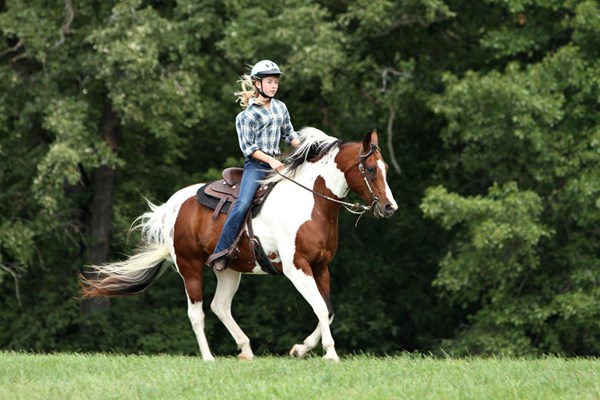 Credit: Thinkstock Rein or bridle lameness is caused by problems in the horse-rider communication and is a learned lameness.
Credit: Thinkstock Rein or bridle lameness is caused by problems in the horse-rider communication and is a learned lameness.“Rein or bridle lameness” is a gait irregularity in which the cause is usually from resistance, not due to pain. It is a regular gait irregularity. It is best seen, perhaps only seen, when the horse is ridden. It can look like a “straight-forward” front leg lameness (such as 2/5 lameness on the leg to the outside of a circle) or a mixture of front and hind leg lameness.
Many times, the rein lameness gait is called a “cat-trot.” The gait irregularity appears as if the horse is trying to break into a canter from a trot, but falls back into a trot while the horse resists going forward. When the rider continues to put leg on, the horse will raise its head up as it raises the lead front leg up and forward, making it look like a lameness, then come back to trot before it actually breaks into a canter.
There may be an abnormal synchrony of the horse and rider’s tension through the reins.
Early on in the syndrome, other riders can ride the horse and the horse is normal gaited. Also, early on in the syndrome, the horse on a longe line without rein pressure appears to be sound. However, as time goes on, months and maybe years, as the rider “rides the lameness,” the gait becomes imprinted in the horse’s mind. At this point it can become difficult to retrain that horse, especially with that specific rider.
If the examiner delves back into the history far enough, there may have been some underlying or initiating pain that could have promoted the development of rein lameness with that particular rider. But now the pain is gone and the gait is irregular. It can be extremely difficult from a psychological perspective for the veterinarian to be in the middle of the horse, the rider and the trainer when there is significant denial that a lameness can occur without pain. So it is important to work at the diagnosis from the process of elimination along with the amount of gait irregularities not matching the amount of pain observed.
It probably requires more than one examination. Obviously, routine lameness, neurological, and dental exams should be done, which may include negative blocks, radiographs and possibly referral for nuclear scintigraphy. Some “discrimination testing” can be done with the horse on a specific medication (such as an NSAID to reduce general inflammation), keeping the horse and rider in training, to see if the gait irregularity changes. If the lameness does not go away, it helps support that inflammation is not part of the process. Use of videography maybe helpful to see what is happening and if there is improvement occurring.
Current treatment is using some rehabilitative ground and riding exercises to help recondition the horse and rider. If bending exercises are developed, they can be used as a form of “discrimination testing.” Tight circles can help with rein lameness, whereas they would increase lameness in, for instance, a foot sore horse. It can be a very difficult problem to diagnose and treat.
For more articles from North Carolina State University College of Veterinary Medicine, visit their website.


